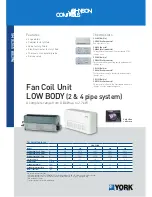
Installation
2. Rotate the indicator through the top-center position to the right side, 180° from the start
position (3 o’clock).
3. Record the indicator reading.
When the reading value is...
Then...
Negative
The coupling halves are farther apart on the right side than
the left. Perform one of these steps:
• Slide the shaft end of the driver to the left.
• Slide the opposite end to the right.
Positive
The coupling halves are closer together on the right side
than the left. Perform one of these steps:
• Slide the shaft end of the driver to the right.
• Slide the opposite end to the left.
Figure 13: Example of incorrect horizontal alignment (top view)
4. Repeat the previous steps until the permitted reading value is achieved.
Perform parallel alignment for a vertical correction
Refer to the alignment table in "Permitted indicator values for alignment checks" (see Table of
Contents for location of table) for the proper cold alignment value based on the motor
temperature rise and the pump operating temperature.
Before you start this procedure, make sure that the dial indicators are correctly set up.
A unit is in parallel alignment when the parallel indicator (P) does not vary by more than
0.002 in. (0.05 mm) as measured at four points 90° apart at the operating temperature.
1. Set the parallel alignment indicator (P) to zero at the top-center position (12 o’clock) of the
driver coupling half (Y).
2. Rotate the indicator to the bottom-center position (6 o’clock).
3. Record the indicator reading.
When the reading value is...
Then...
Negative
The pump coupling half (X) is lower than the
driver coupling half (Y). Remove shims of a
thickness equal to half of the indicator reading
value under each driver foot.
Positive
The pump coupling half (X) is higher than the
driver coupling half (Y). Add shims of a thickness
equal to half of the indicator reading value to each
driver foot.
Model 3610, API Type BB1 API 610 11th Edition Installation, Operation, and Maintenance Manual
27
















































